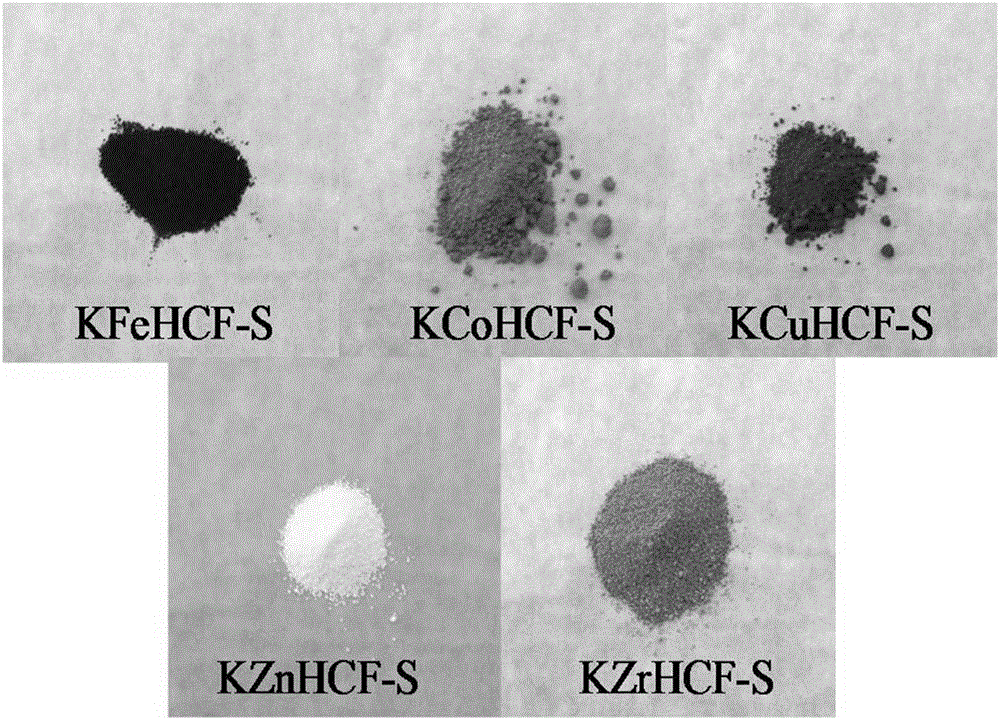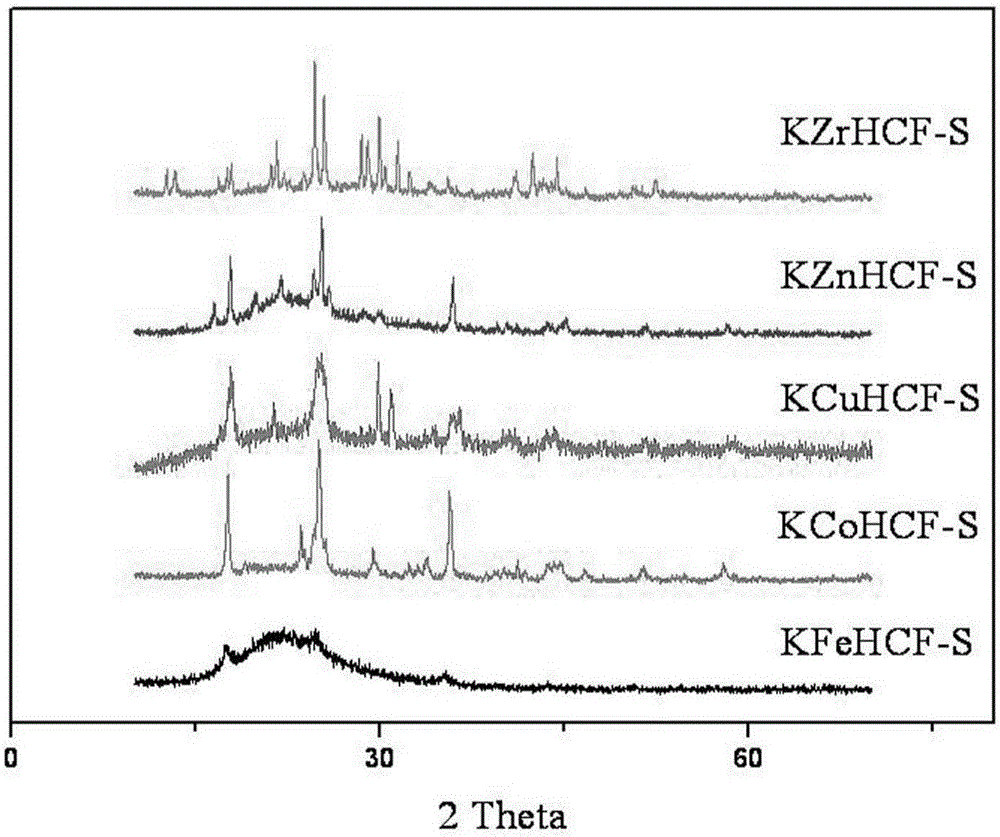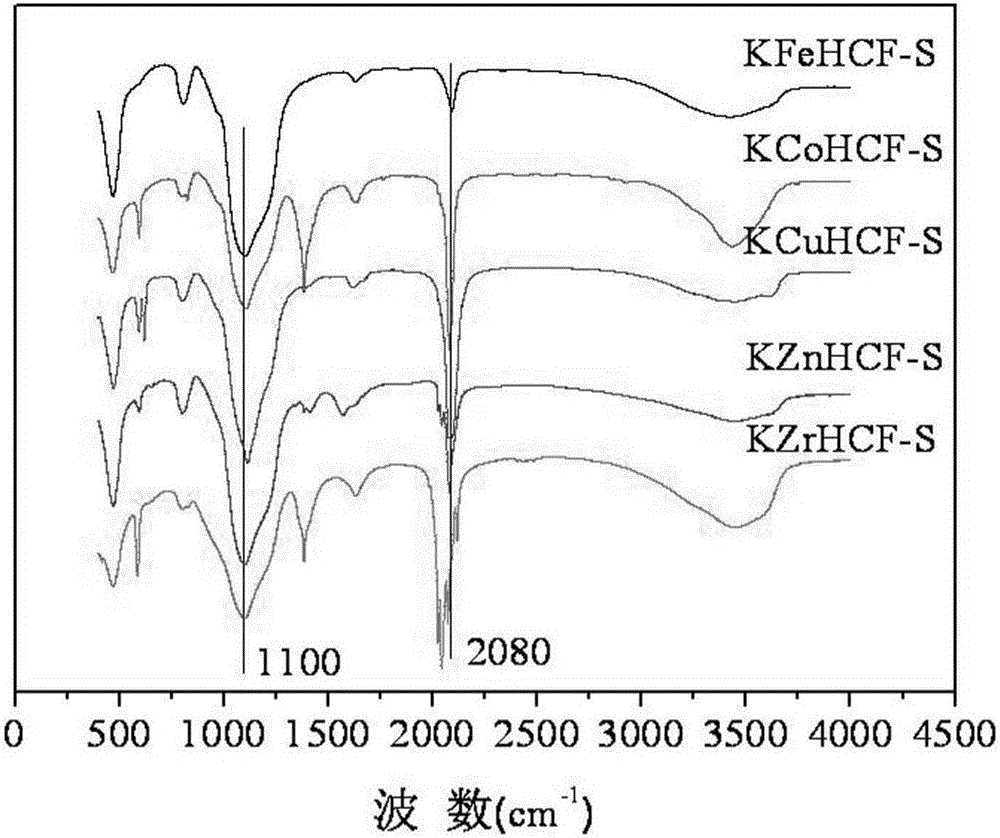Preparation method of particulate cesium removal inorganic ion adsorbent, and product and application of adsorbent
A technology of inorganic ions and adsorbents, which is applied in the preparation of composite adsorption materials and in the field of granular inorganic ion adsorbents. It can solve the problems of active ingredient loss, secondary pollution, and reduced adsorbent performance, and achieve high adsorption performance and stable structure. , the effect of broad application prospects
- Summary
- Abstract
- Description
- Claims
- Application Information
AI Technical Summary
Problems solved by technology
Method used
Image
Examples
Embodiment 1
[0058] Embodiment 1: the laboratory preparation of five kinds of silica gel-loaded adsorbents
[0059] Two-step impregnation method to prepare silica-supported adsorbent:
[0060] 1) Add 4L of deionized water to five 10L beakers respectively, add: A-630g of Co(NO 3 ) 2 ·6H 2 O; B - 790g of CuSO 4 ·5H 2 O; C-180g (CH 3 COO) 2 Zn·2H 2 O; D-1020g of ZrO(NO 3 ) 2 ; E-430g FeCl 3 ·6H 2 O. Heat and stir until completely dissolved, then pour the five solutions into five enamel trays each containing 1kg of silica gel particles, the solution is basically immersed in all the silica gel, and stand for 3 hours, stirring often during the process to make the particles impregnated evenly. Then put the 5 trays in a constant temperature oven and dry them at 120°C for 10 hours, then take them out and cool down naturally to obtain silica gel intermediates impregnated with different ions.
[0061] 2) Add 5L of deionized water to each of the five 10L beakers of A, B, C, D, and E, resp...
Embodiment 2
[0067] Example 2: Trial production of a single batch of 500kg KCuHCF-S
[0068] Add 500L of water to a 1 ton reaction box, and add 395kg of CuSO 4 ·5H 2 O, heated to 80°C with continuous stirring to dissolve completely. Then add 500kg of silica gel carrier, impregnate at 80°C for 12 hours, and stir frequently during the process to make the adsorption process uniform. Afterwards, the material was filtered, placed in a tray, and dried in an electric blast drying room at 120°C for 24 hours. The filtrate was collected and the water uptake of the first maceration was determined by volume. Pour the filtrate back into the reaction box, and add water in it, so that the volume of the solution is equal to the amount of water absorbed for the first time. Put the dried material into the reaction box again, repeat the first impregnation process and operating conditions until the solution is basically absorbed. Place the material in a tray again, and dry it in an electric blast drying ...
Embodiment 3
[0071] Example 3: Trial production of 500kg KZnHCF-S in a single batch
[0072] Add 500L water in 1 ton of reaction box, add 92kg (CH 3 COO) 2 Zn·2H 2 O, heated to 40°C with continuous stirring to dissolve completely. Then add 500kg of silica gel carrier, impregnate at 40°C for 12 hours, and stir frequently during the process to make the adsorption process uniform. Afterwards, the material was filtered, placed in a tray, and dried in an electric blast drying room at 120°C for 24 hours. The filtrate was collected and the water uptake of the first maceration was determined by volume loss. Pour the filtrate back into the reaction box, add water to make the volume of the solution equal to the first water absorption. Put the dried material into the reaction box again, repeat the first impregnation process and operating conditions until the solution is basically absorbed. Place the material in the tray again, and dry it in an electric blast drying room at 120°C for 24 hours to...
PUM
| Property | Measurement | Unit |
|---|---|---|
| pore size | aaaaa | aaaaa |
| particle size | aaaaa | aaaaa |
| diameter | aaaaa | aaaaa |
Abstract
Description
Claims
Application Information
 Login to View More
Login to View More - R&D
- Intellectual Property
- Life Sciences
- Materials
- Tech Scout
- Unparalleled Data Quality
- Higher Quality Content
- 60% Fewer Hallucinations
Browse by: Latest US Patents, China's latest patents, Technical Efficacy Thesaurus, Application Domain, Technology Topic, Popular Technical Reports.
© 2025 PatSnap. All rights reserved.Legal|Privacy policy|Modern Slavery Act Transparency Statement|Sitemap|About US| Contact US: help@patsnap.com



